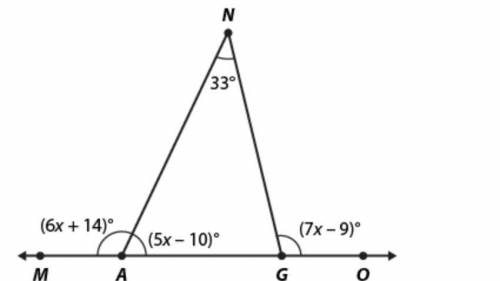
Mathematics, 18.10.2020 04:01 derrekdream123
Look at the figure below.
Select TWO equations that represent angle relationships in the figure.
A
7x−9=6x+14
B
7x−9=5x−10+33
C
6x+14=33+180−(7x−9)
D
33+(5x−10)+(7x−9)=180


Answers: 3


Another question on Mathematics

Mathematics, 21.06.2019 12:30
The diagram shows a 7cm by 6cm rectangle based pyramid. all the diagonal sides - ta, tb, tc and td are length 10cm. m is midpoint of rectangular base. work out height mt to 1 decimal place
Answers: 1

Mathematics, 21.06.2019 14:30
Brent works part-time at a clothing store. he earns an hourly wage of $15. if he needs to earn more than $45 in a day and works for x hours a day, which inequality represents this situation? a. 15x > 45 b. 15x < 60 c. x > 60 d. 15x < 45 e. x < 60
Answers: 1

Mathematics, 21.06.2019 19:00
There is an entrance to the computer room at point e which lies on ab and is 5 feet from point a. plot point e on the coordinate plane. find the distance from the entrance at point e to the printer at point e
Answers: 1

Mathematics, 21.06.2019 23:30
In a study of the relationship between socio-economic class and unethical behavior, 129 university of california undergraduates at berkeley were asked to identify themselves as having low or high social-class by comparing themselves to others with the most (least) money, most (least) education, and most (least) respected jobs. they were also presented with a jar of individually wrapped candies and informed that the candies were for children in a nearby laboratory, but that they could take some if they wanted. after completing some unrelated tasks, participants reported the number of candies they had taken. it was found that those who were identiď¬ed as upper-class took more candy than others. in this study, identify: (a) the cases, (b) the variables and their types, (c) the main research question, (d) identify the population of interest and the sample in this study, and (e) comment on whether or not the results of the study can be generalized to the population, and if the ď¬ndings of the study can be used to establish causal relationships.
Answers: 2
You know the right answer?
Look at the figure below.
Select TWO equations that represent angle relationships in the figure.
Questions




Mathematics, 19.06.2020 22:57



Mathematics, 19.06.2020 22:57

Mathematics, 19.06.2020 22:57

Computers and Technology, 19.06.2020 22:57

History, 19.06.2020 22:57

History, 19.06.2020 22:57

English, 19.06.2020 22:57




Mathematics, 19.06.2020 22:57







